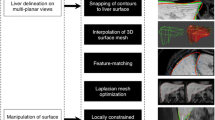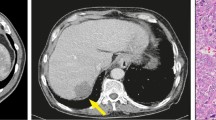Abstract
Purpose
Our purpose is to develop a fully automated scheme for liver volume measurement in abdominal MR images, without requiring any user input or interaction.
Methods
The proposed scheme is fully automatic for liver volumetry from 3D abdominal MR images, and it consists of three main stages: preprocessing, rough liver shape generation, and liver extraction. The preprocessing stage reduced noise and enhanced the liver boundaries in 3D abdominal MR images. The rough liver shape was revealed fully automatically by using the watershed segmentation, thresholding transform, morphological operations, and statistical properties of the liver. An active contour model was applied to refine the rough liver shape to precisely obtain the liver boundaries. The liver volumes calculated by the proposed scheme were compared to the “gold standard” references which were estimated by an expert abdominal radiologist.
Results
The liver volumes computed by using our developed scheme excellently agreed (Intra-class correlation coefficient was 0.94) with the “gold standard” manual volumes by the radiologist in the evaluation with 27 cases from multiple medical centers. The running time was 8.4 min per case on average.
Conclusions
We developed a fully automated liver volumetry scheme in MR, which does not require any interaction by users. It was evaluated with cases from multiple medical centers. The liver volumetry performance of our developed system was comparable to that of the gold standard manual volumetry, and it saved radiologists’ time for manual liver volumetry of 24.7 min per case.





Similar content being viewed by others
References
Radtke A, Sotiropoulos GC, Nadalin S, Molmenti EP, Schroeder T, Lang H, Saner F, Valentin-Gamazo C, Frilling A, Schenk A, Broelsch CE, Malagó M (2007) Preoperative volume prediction in adult living donor liver transplantation: how much can we rely on it? Am J Transpl 7(3):672–9
Seghers D, Slagmolen P, Lambelin Y, Hermans J, Loeckx D, Maes F, Suetens P (2007) Landmark based liver segmentation using local shape and local intensity models. In: Proc MICCAI Workshop3-D Segmentat. Clinic: a grand challenge, pp 135–142
Li G, Chen X, Shi F, Zhu W, Tian J, Xiang D (2015) Automatic liver segmentation based on shape constraints and deformable graph cut in CT images. IEEE Trans Image Process 24(12):5315–5329
Suzuki K, Epstein ML, Kohlbrenner R, Garg S, Hori M, Oto A, Baron RL (2011) Quantitative radiology: automated CT liver volumetry compared with interactive volumetry and manual volumetry. Med Phys Inform AJR 197:W706–W712
Göçeri E, Zübeyir M, Dicle O (2013) A comparative performance evaluation of various approaches for liver segmentation from SPIR images. Turk J Electr Eng Comput Sci (TJEECS) 23:741–768
Göçeri E (2016) Fully automated liver segmentation using Sobolev gradient-based level set evolution. Int J Numer Methods Biomed Eng. doi:10.1002/cnm.2765
Gloger O, Kühn J, Stanski A, Völzke H, Puls R (2010) A fully automatic three-step liver segmentation method on LDA-based probability maps for multiple contrast MR images. Magn Reson Imaging 28:882–897
Rusko L, Bekes G (2011) Liver segmentation for contrast-enhanced MR images using partitioned probabilistic model. Int J Comput Assist Radiol Surg 6:13–20
Masoumi H, Behradb A, Pourminaa MA, Roosta A (2012) Automatic liver segmentation in MRI images using an iterative watershed algorithm and artificial neural network. Biomed Signal Process Control 7:429–437
Huynh HT, Karademir I, Oto A, Suzuki K (2014) Computerized liver volumetry on MRI by using 3D geodesic active contour segmentation. Med Phys Inform AJR 202:152–159
Le TN, Bao PT, Huynh HT (2015) Fully automatic scheme for measuring liver volume in 3D MR images. In: The 4th international conference on biomedical engineering and biotechnology (ICBE2015), pp S1361-S1369
Suzuki K, Horiba I, Sugie N (2003) Linear-time connected-component labeling based on sequential local operations. Computer Vis Image Underst 89:1–23
He L, Chao Y, Suzuki K, Wu K (2009) Fast connected-component labeling. Pattern Recognit 42:1977–1987
Caselles V, Kimmel R, Sapiro G (1997) Geodesic active contours. Int J Computer Vis 22:61–79
Portney LG, Watkins MP (1993) Foundations of clinical research: applications to practice, 2nd edn. Appleton and Lange, Norwalk
Florin C, Paragios N, Funka-Lea G, Williams J (2007) Liver segmentation using sparse 3D prior models with optimal data support. Inf Process Med Imaging 20:38–49
Freiman M, Eliassaf O, Taieb Y, Joskowicz L, Azraq Y, Sosna J (2008) An iterative Bayesian approach for nearly automatic liver segmentation: algorithm and validation. Int J Comput Assist Radiol Surg 3:439–446
Sandrasegaran K, Kwo PW, DiGirolamo D, Stockberger SM Jr, Cummings OW, Kopecky KK (1999) Measurement of liver volume using spiral CT and the curved line and cubic spline algorithms: reproducibility and interobserver variation. Abdom Imaging 24:61–65
Acknowledgements
This research is funded by the Vietnam National Foundation for Science and Technology Development (NAFOSTED) under grant number 102.01-2013.47.
Author information
Authors and Affiliations
Corresponding author
Ethics declarations
Conflict of interest
The authors declare that they have no conflict of interest.
Research involving human participants
All procedures performed in studies involving human participants were in accordance with the ethical standards of the institutional and/or national research committee and with the 1964 Helsinki declaration and its later amendments or comparable ethical standards. This article does not contain any studies with animals performed by any of the authors.
Informed consent
Informed consent was obtained from all individual participants included in the study.
Rights and permissions
About this article
Cite this article
Huynh, H.T., Le-Trong, N., Bao, P.T. et al. Fully automated MR liver volumetry using watershed segmentation coupled with active contouring. Int J CARS 12, 235–243 (2017). https://doi.org/10.1007/s11548-016-1498-9
Received:
Accepted:
Published:
Issue Date:
DOI: https://doi.org/10.1007/s11548-016-1498-9




